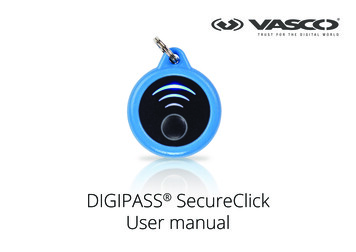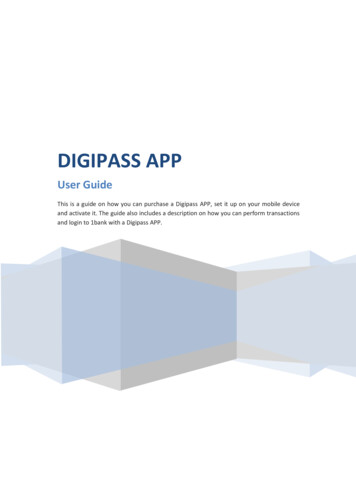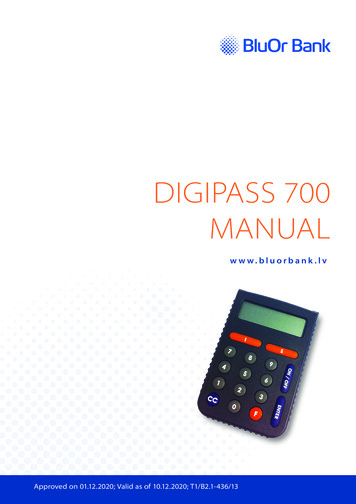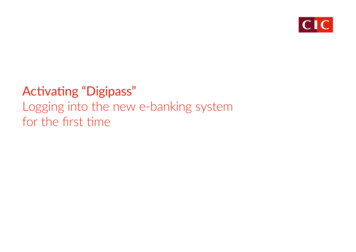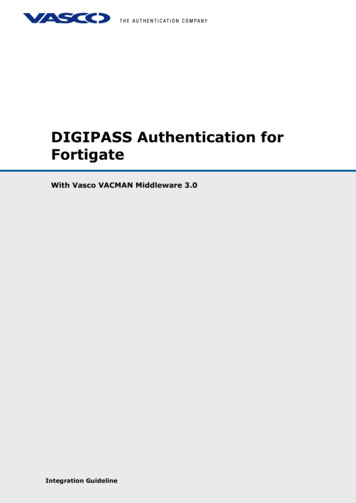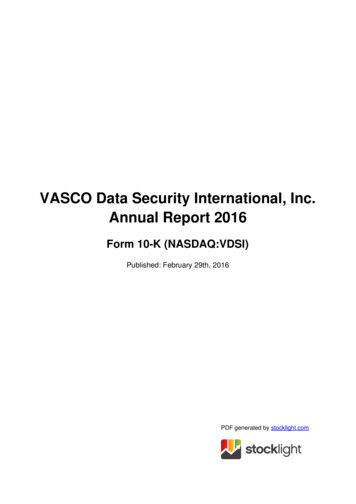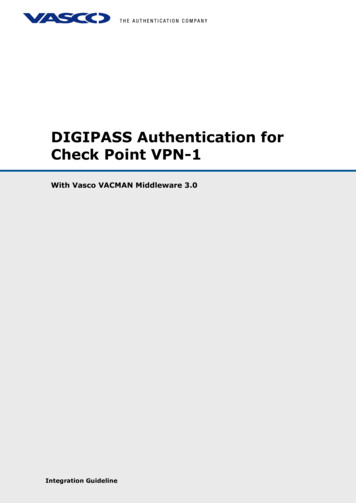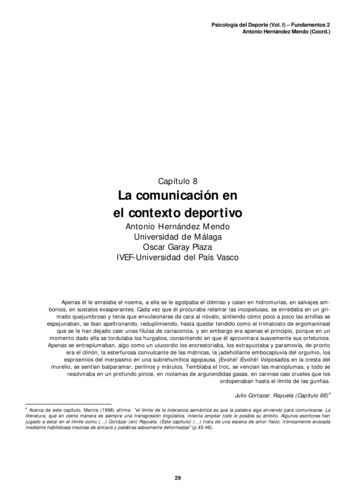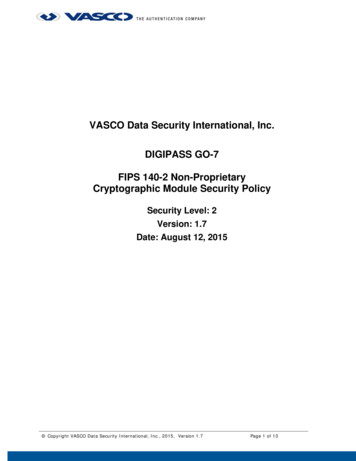
Transcription
VASCO Data Security International, Inc.DIGIPASS GO-7FIPS 140-2 Non-ProprietaryCryptographic Module Security PolicySecurity Level: 2Version: 1.7Date: August 12, 2015 Copyright VASCO Data Security International, Inc., 2015, Version 1.7Page 1 of 13
Table of ContentsTABLE OF CONTENTS . 2LIST OF FIGURES . 3LIST OF TABLES . 31INTRODUCTION . 41.11.21.31.42PURPOSE . 4COPYRIGHT . 4REFERENCES . 4ACRONYMS . 4CRYPTOGRAPHIC MODULE SPECIFICATION . 52.1MODULE DESCRIPTION . 52.1.1Overview. 52.1.2Module Validation Level . 52.2HARDWARE AND PHYSICAL CRYPTOGRAPHIC BOUNDARY . 62.3FIRMWARE AND LOGICAL CRYPTOGRAPHIC BOUNDARY . 62.3.1Hardware block diagram . 62.3.2Logical block diagram . 72.4MODE OF OPERATION . 73CRYPTOGRAPHIC FUNCTIONALITY . 83.13.23.34CRYPTOGRAPHIC FUNCTIONS . 8CRITICAL SECURITY PARAMETERS . 8DEFAULT AUTHENTICATION DATA . 8ROLES, SERVICES AND AUTHENTICATION . 94.14.24.3ROLES . 9SERVICES . 9AUTHENTICATION METHODS . 115ELECTROMAGNETIC INTERFERENCE/ELECTROMAGNETIC COMPATIBILITY (EMI / EMC) . 126SELF‐TESTS . 127PHYSICAL SECURITY POLICY. 128OPERATIONAL ENVIRONMENT . 129MITIGATION OF OTHER ATTACKS POLICY . 1210SECURITY RULES AND GUIDANCE . 13 Copyright VASCO Data Security International, Inc., 2015, Version 1.7Page 2 of 13
List of FiguresFIGURE 1: COVER OF MODULE (FRONT AND BACK) . 6FIGURE 2: HARDWARE BLOCK DIAGRAM OF THE MODULE . 6FIGURE 3: LOGICAL BLOCK DIAGRAM OF THE MODULE . 7List of TablesTABLE 1: REFERENCES. 4TABLE 2: ACRONYMS . 4TABLE 3: CRYPTOGRAPHIC MODULE CONFIGURATION. 5TABLE 4: SECURITY LEVEL OF SECURITY REQUIREMENTS . 5TABLE 5: PORTS AND INTERFACES . 6TABLE 6: APPROVED AND CAVP VALIDATED CRYPTOGRAPHIC FUNCTIONS . 8TABLE 7: CRITICAL SECURITY PARAMETERS (CSPS) . 8TABLE 8: DEFAULT AUTHENTICATION DATA . 8TABLE 9: ROLES DESCRIPTION . 9TABLE 10: AUTHENTICATED SERVICES . 9TABLE 11: UNAUTHENTICATED SERVICES . 9TABLE 12: CSP AND SSP ACCESS RIGHTS WITHIN SERVICES . 10TABLE 13: AUTHENTICATION DESCRIPTION. 11TABLE 14: POWER UP SELF‐TESTS . 12TABLE 15: PHYSICAL SECURITY INSPECTION GUIDELINES . 12 Copyright VASCO Data Security International, Inc., 2015, Version 1.7Page 3 of 13
1Introduction1.1PurposeThis document defines the non-proprietary Security Policy for the DIGIPASS GO-7 cryptographicmodule from VASCO Data Security International, Inc. hereafter denoted the Module.The Module is a hardware Time-based One-Time Password (OTP) Token.This Security Policy describes how the Module meets the requirements of Federal InformationProcessing Standard (FIPS) Publication 140-2 Level 2 requirements.1.2CopyrightThis Security Policy document is copyright VASCO Data Security International, Inc. This SecurityPolicy may be reproduced and distributed only in its original entirety without any revision.1.3ReferencesTable 1 lists the standards referred to in this Security Policy.Table 1: ReferencesAbbreviationFull Name[FIPS140-2]Security Requirements for Cryptographic Modules, May 25, 2001[SP800-131A]Transitions: Recommendation for Transitioning the Use of Cryptographic Algorithms andKey Lengths, January 2011[SP800-108]Recommendation for Key Derivation Using Pseudorandom Functions (Revised), October20091.4AcronymsTable 2 defines the acronyms found in this document.Table 2: AcronymsAcronymDefinitionAESAdvanced Encryption StandardCMACCipher-based MACCOCryptographic OfficerECBElectronic Codebook mode of operationEMIElectromagnetic InterferenceEMCElectromagnetic CompatibilityFIPSFederal Information Processing StandardFIPS PUBFIPS PublicationFWFirmwareHWHardwareKATKnown Answer TestKDFKey Derivation FunctionMACMessage Authentication CodeNISTNational Institute of Standards and TechnologyOTPOne-Time Password Copyright VASCO Data Security International, Inc., 2015, Version 1.7Page 4 of 13
2Cryptographic Module Specification2.1Module Description2.1.1OverviewThe Module is a multi-chip standalone embodiment. The hardware part number and firmwareversion of the Module are as follows:Table 3: Cryptographic Module Configuration1ModuleHardware Part Number and VersionFirmware versionDIGIPASS GO-7DIGIPASS GO-7 FIPS 140-20355The Module is intended for use by US federal agencies and other markets that require FIPS 140-2validated One-Time Password Tokens.2.1.2Module Validation LevelThe module is intended to meet requirements of FIPS 140-2 security level 2 overall.The following table shows the security level for each of the eleven requirement areas.Table 4: Security Level of Security RequirementsSecurity Requirement AreaSecurity LevelCryptographic Module Specification2Cryptographic Module Ports and Interfaces2Roles, Services, and Authentication2Finite State Model2Physical Security2Operational EnvironmentN/ACryptographic Key Management2EMI / EMC3Self-Tests2Design Assurance3Mitigation of Other Attacks Copyright VASCO Data Security International, Inc., 2015, Version 1.7N/APage 5 of 13
2.2Hardware and Physical Cryptographic BoundaryThe physical form of the Module is depicted in Figure 1. The cryptographic boundary is the outeredge of the enclosure which encompasses the entire device.Figure 1: Cover of Module (front and back)Table 5 below defines ports and interfaces of the Module.Table 5: Ports and InterfacesPortDescriptionLogical Interface TypePush ButtonPowers on the moduleand allows for theselection of OTP todisplay.Control inLCD DisplayDisplays OTPs, Status,and Error codes.Data out Status outDIGIPASS InitializationInterfaceAllows for the loading ofthe Master Device Key,setting the time, andresettingtofactorydefaults.Control in Data in Data out Status out2.3 Firmware and Logical Cryptographic Boundary2.3.1Hardware block diagramFigure 2 depicts the hardware block diagram of the Module.Figure 2: Hardware block diagram of the Module Copyright VASCO Data Security International, Inc., 2015, Version 1.7Page 6 of 13
The Module consists of the following hardware components: Microprocessor. This is a general-purpose low power micro controller with followingcharacteristics:o 4 Kbyte One-Time-Programmable code memoryo 128 bytes static RAMo LCD controllero Clockso General purpose I/O ports Initialization interface. This interface, based on contacts via pins, is used to load theModule’s personalization data (e.g., serial number, cryptographic keys, etc.) into the RAMof the micro controller. Display. The display consists of an 8-digit seven segment glass LCD panel, directly drivenby the micro controller. Power supply. The micro controller is continuously powered during its complete lifecycle,also during power off, in order to guarantee retention of data in RAM. During power off thevoltage is reduced to reduce power consumption. Keyboard. The keyboard consists of a single button, directly connected to a generalpurpose I/O pin.2.3.2Logical block diagramFigure 3 depicts the logical block diagram of the Module.Figure 3: Logical block diagram of the ModuleThe Module consists of the following logical components: Operating System (OS). The OS manages the hardware peripherals, the powermanagement and invokes the applets. Runtime (RT) Libraries. The runtime libraries implement the cryptographic algorithms andthe One-Time Password (OTP) algorithm. FAT Applet. The Factory Acceptance Test Applet is a test application used duringproduction of the Module to check the hardware during different production quality tests. LOAD Applet. The Load Applet is used during the initialization of the Module in order toload the Module’s personalization data (e.g., serial number, cryptographic keys, etc.). AUTHENTICATION Applet. The Authentication Applet is used to generate One-TimePasswords.2.4 Mode of OperationThe Module only supports an approved mode of operation. To verify that a module is in theApproved mode of operation, the user of the Module should verify that the label of the Modulecontains the hardware part number and firmware version listed in Section 2.1.1. Copyright VASCO Data Security International, Inc., 2015, Version 1.7Page 7 of 13
3Cryptographic Functionality3.1Cryptographic FunctionsThe Module implements the following FIPS Approved cryptographic functions listed in the tablebelow.Table 6: Approved and CAVP Validated Cryptographic FunctionsAlgorithmDescriptionCert #AESStandard: [FIPS 197, SP 800-38A]Functions: EncryptionModes: ECBKey sizes: 128-bitsAES #3216AESCMACStandard: [SP 800-38B]Functions: GenerationKey sizes: AES with 128-bitsAES #3217KDF, usingPseudorandomFunctionsStandard: [SP 800-108]Modes: Counter ModeFunctions: CMAC-based KDF with AES 128-bitsKBKDF #443.2 Critical Security ParametersThe table below lists and describes all CSPs used by the Module. All usage of these CSPs by theModule (including all CSP lifecycle states) is described in the services detailed in Section 4.Table 7: Critical Security Parameters (CSPs)CSPDescription / UsageMaster Device Key128-bit AES key, used to derive the Device Authentication Key andDevice Application Keys.DeviceAuthentication Key128-bit AES key used to authenticate operators once the module isinitialized, derived from the Master Device Key. This key is used by theUser role and the Cryptographic Officer role, as defined in Section 4.1.DeviceKey128-bit AES keys used to generate One-Time Passwords, derived fromthe Master Device Key.Application3.3 Default Authentication DataThe table below lists and describes the Default Authentication Data used by the Module.Table 8: Default Authentication DataDataDescription / UsageMasterFactory Key128-bit AES key, used to derive Factory Authentication Key.FactoryAuthenticationKey128-bit AES key used as default authentication data while the module is beinginitialized, derived from the Master Factory Key. The Factory AuthenticationKey is used by the Cryptographic Officer role, as defined in Section 4.1. Copyright VASCO Data Security International, Inc., 2015, Version 1.7Page 8 of 13
4Roles, Services and Authentication4.1 RolesThe module supports two distinct operator roles, User and Cryptographic Officer (CO). The rolesare assumed to be assigned to the same entity. The cryptographic module enforces the separationof roles by restricting one authentication per module reset. Re-authentication is not supported.Table 9 lists all operator roles supported by the module. The Module does not support amaintenance role and/or bypass capability. The Module does not support concurrent operators.The module clears the authentication state when the module is power cycled.Table 9: Roles DescriptionRole IDRole DescriptionAuthentication TypeAuthentication DataCryptographicOfficer (CO)Initialize the moduleand set the Key(duringinitialization) or Master DeviceKey proven by creating an OTPUserSet the Key(duringinitialization) or Master DeviceKey proven by creating an OTPThe Factory Authentication Key is embedded inside the firmware of the Module and is considereddefault authentication data. The firmware is stored within the processor, inside the Module’stamper-evident casing. The Master Device Key is loaded into the Module’s processor RAM duringinitialization of the Module.4.2 ServicesAll services implemented by the Module are listed in the tables below. Each service descriptionalso describes all usage of CSPs by the service.Table 10: Authenticated orKnowledge of the Factory Authentication Key (duringinitialization) or Master Device Key proven by creating anOTPXXLoadMasterDevice KeyWrites the Master Device Key.XXSet timeSets the time for the module’s internal real-time clock.XXTable 11: Unauthenticated ServicesServicePower-UpModuleExecute Self-TestsShow StatusDescription//Power-up the module by pressing the Push Button. The moduleperforms the self-tests and shows the state of the module (uninitialized,error, operational).Retrieve Module statusRetrieves status information from the Module, such as its battery status,current time, firmware version, and Serial Number.Generate OTPReads the Master Device Key, derives a Device Application Key, readsthe Time, and uses the Device Application Key and Time to calculate aOne-Time Password. Copyright VASCO Data Security International, Inc., 2015, Version 1.7Page 9 of 13
ServiceResetDefaultsDescriptiontoFactoryDestroys all CSPs by writing zeros over the Static RAM locations of theMaster Device Key, Device Application Keys, and Device AuthenticationKeys.In order to perform the authenticated services, the Cryptographic Officer or User puts the Moduleonto a so-called DIGILINK device. This device is used to load the Master Device Key and set thetime of the Module.Table 12 defines the relationship between access to CSPs and the different module services. Themodes of access shown in the table are defined as: Generate (G): The module generates the CSP. Read (R): The module reads the CSP. The read access is typically performed before themodule uses the CSP. Execute (E): The module executes using the CSP. Write (W): The module writes the CSP. The write access is typically performed after a CSPis imported into the module, when the module generates a CSP, or when the moduleoverwrites an existing CSP. Zeroize (Z): The module zeroizes the CSP.Table 12: CSP and SSP Access Rights within ServicesAuthenticateOperatorRELoad MasterDevice KeyWDevice er Device KeyCSPsGESet TimePowerUpModule/Execute SelfTests / ShowStatusRetrieveModule statusGenerateOTPResetFactoryDefaultsREtoZGEZ Copyright VASCO Data Security International, Inc., 2015, Version 1.7ZPage 10 of 13
4.3 Authentication MethodsBoth authenticated services described in Section 4.2 use following authentication method:1) The User or Cryptographic Officer obtains the current time from the Module.2) The User or Cryptographic Officer calculates a One-Time Password by encrypting the timestamp from the Module with AES using the appropriate cryptographic key, and selecting 64bits from the output of AES. 4 bits of the 64-bit One-Time Password are replaced by a timesynchronization digit, represented using 4 bits, which is calculated as the remainder of thetime stamp mod 10. The time synchronization digit helps the Module to verify the timestamp used by the User or Cryptographic Officer. The cryptographic key is either theFactory Authentication Key or the Device Authentication Key, and therefore always has alength of 128 bits.3) The User or Cryptographic Officer provides the One-Time Password to the Module.4) The Module verifies the One-Time Password by repeating the calculation process andverifying whether the provided OTP matches the expected OTP.The above process takes approximately one (1) second. This amount of time is mainly the result ofthe speed of the interface that the User and Cryptographic Officer use to communicate with theModule.The strength of the authentication method is based on the following: The usage of AES in the generation of One-Time Passwords ensures that One-TimePasswords are unpredictable and occur with uniform probability. The probability to guess a One-Time Password in one (1) attempt equals 1 / 2 60, as thelength of a One-Time Password, excluding the time synchronization digit, equals 60 bits. The probability to guess a One-Time Password in one (1) minute equals 60 / 2 60.Note: The security of the module is dependent on controlling access to any copies of the MasterDevice Key that reside outside of the module. The User or Cryptographic Officer is responsible forensuring an attacker does not obtain the Master Device Key.Table 13: Authentication DescriptionAuthentication MethodFalseAcceptanceProbabilityJustificationFor one attempt: 1/2 60 One-Time PasswordFor multipleduring6060/2 60attemptsseconds: Copyright VASCO Data Security International, Inc., 2015, Version 1.7The usage of AES ensures One-TimePasswords are unpredictable andoccur with uniform probability.The length of a One-Time Password,excluding the time synchronizationdigit, equals 60 bitsSame as for one (1) attemptAdditionally,theauthenticationprocess takes about one (1) secondPage 11 of 13
5Electromagnetic Interference/ElectromagneticCompatibility (EMI / EMC)The Module is compliant with Title 47 of the Code of Federal Regulations (CFR) Part 15, SubpartB, Class B (Home use).6Self-testsEach time the Module is powered up, it tests that the cryptographic algorithms still operate correctlyand that the module has not been modified. Power up self–tests are available on demand by powercycling the module.On power up or reset, the Module performs the self-tests described in Table 14 below. All KATsmust be completed successfully prior to any other use of cryptography by the Module. If one of theKATs fails, the Module enters the error state.Table 14: Power Up Self-testsTest TargetDescriptionFirmware Integrity16-bit checksum performed over all code.KDF,usingPseudorandom FunctionsKATs: CMAC Generation which includes AES ECB Encrypt.Key size: 128-bits7Physical Security PolicyThe Module is a multi-chip stand-alone module that is housed in a production grade plasticenclosure. The parts of the enclosure are shear welded together, so they are non-removable. Anyattempts to open the enclosure will show clear tamper evidence. In the event of tamper evidence,please contact the organization or company that provided the Module immediately.Table 15: Physical Security Inspection GuidelinesPhysical SecurityMechanismRecommended Frequencyof Inspection/TestInspection/Test Guidance DetailsEnclosureUpon every usage of thedeviceVerify that the enclosure is intact andthe token does not show evidence ofprying or cutting attempts.Verify that the size of the holes,covered by the label at the back of theModule, has not increased, as thiswould provide evidence of tampering.8Operational EnvironmentThe Module is designated as a non-modifiable operational environment under the FIPS 140-2definitions. The Module does not support loading new firmware.9Mitigation of Other Attacks PolicyThe module does not implement mitigation of other attacks. Copyright VASCO Data Security International, Inc., 2015, Version 1.7Page 12 of 13
10Security Rules and GuidanceThe Module design corresponds to the Module security rules. This section documents the securityrules enforced by the cryptographic module to implement the security requirements of this FIPS140-2 Level 2 module.The Module enforces following security rules:1. The module provides two distinct operator roles: User and Cryptographic Officer.2. The module provides role-based authentication.3. The module clears previous authentications on power cycle.4. When the module has not been placed in a valid role, the operator can use the Module togenerate One-Time Passwords.5. The operator shall be capable of commanding the module to perform the power up selftests by cycling power or resetting the module.6. Power up self-tests do not require any operator action.7. Data output shall be inhibited during key generation, self-tests, zeroization, and errorstates.8. Status information does not contain CSPs or sensitive data that if misused could lead to acompromise of the module.9. There are no restrictions on which keys or CSPs are zeroized by the zeroization service.10. The module does not support concurrent operators.11. The module does not support a maintenance interface or role.12. The module does not support manual key entry.13. The module has external input/output devices used for entry/output of data.14. The module enters plaintext CSPs.15. The module does not output plaintext CSPs.16. The module does not output intermediate key values.17. The Cryptographic Officer must ensure that the Master Device Key provides 128-bits ofsecurity strength. Copyright VASCO Data Security International, Inc., 2015, Version 1.7Page 13 of 13
This Security Policy document is copyright VASCO Data Security International, Inc. This Security Policy may be reproduced and distributed only in its original entirety without any revision. 1.3 References Table 1 lists the standards referred to in this Security Policy. Table 1: References Abbreviation Full Name

